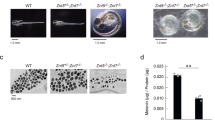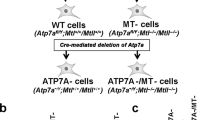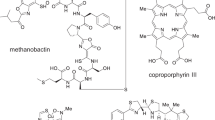Abstract
Copper is an essential constituent of many proteins which participate in biologically important reactions1. In contrast to iron, where different metal storage and transport proteins have been extensively characterised, the existence of copper proteins serving such functions is still a matter of controversy2–8. Studies on the biosynthesis of tyrosinase from Neurospora crassa with respect to the copper status of this fungus have shown that this organism accumulates copper with the concomitant synthesis of a small molecular weight copper-binding protein. This protein is now shown to have a striking sequence homology to the zinc-and cadmium-containing metallothioneins from vertebrates9. Growth experiments suggest that this molecule fulfills several important physiological functions in this organism such as copper storage, copper detoxification and provision of copper for tyrosinase.
This is a preview of subscription content, access via your institution
Access options
Subscribe to this journal
Receive 51 print issues and online access
$199.00 per year
only $3.90 per issue
Buy this article
- Purchase on Springer Link
- Instant access to full article PDF
Prices may be subject to local taxes which are calculated during checkout
Similar content being viewed by others
References
Ochiai, E. I. Bioinorganic Chemistry: An Introduction, 218–262 (Allyn and Bacon, Boston, 1977).
Frieden, E. Trends biochem. Sci. 1, 273–294 (1976).
Hartman, H.-J. & Weser, U. Biochim. biophys. Acta 491, 211–222 (1977).
Bremner, I. & Young, B. W. Biochem. J. 155, 631–635 (1976).
Winge, D. R., Premakumar, R., Wiley, R. & Rajagopalan, K. V. Archs Biochem. Biophys. 170, 253–266 (1975).
Riordan, J. R. & Cover, I. Biochem, biophys. Res. commun. 66, 678–686 (1975).
Prinz, R. & Weser, U. Hoppe-Seyler's Z. physiol. Chem. 356, 767–776 (1975).
Premakumar, R., Winge, D. R., Wiley, R. D. & Rajagopalan, K. V. Archs Biochem. Biophys. 170, 278–288 (1975).
Kojima, Y. & Ka̧gi, J. H. R. Trends biochem. Sci. 3, 90–93 (1978).
Friedman, N., Krull, L. H. & Gavins, J. F. J. biol. Chem. 245, 3868–3871 (1970).
Cole, D. R. Meth. Enzym. 11, 315–317 (1967).
Kissling, M. M. & Ka̧gi, J. H. R. FEBS Lett. 82, 247–250 (1977).
Kojima, Y., Berger, C., Vallee, B. L. & Ka̧gi, J. H. R. Proc. natn. Acad. Sci. U.S.A. 73, 3413–3417 (1976).
Huang, I-Y., Yoshida, A., Tsounoo, H. & Nakajima, H. J. biol. Chem. 252, 8217–8221 (1977).
Vortisch, V., Kronek, P. & Hemmerich, P. J. Am. chem. Soc. 98, 2821–2826 (1976).
Medical and Biological Effects of Environmental Pollutants: Copper (National Academy of Sciences, Washington, DC, 1977).
Vogel, N. J. Microbiol. Genet. Bull. 13, 42–43 (1956).
Author information
Authors and Affiliations
Rights and permissions
About this article
Cite this article
Lerch, K. Copper metallothionein, a copper-binding protein from Neurospora crassa. Nature 284, 368–370 (1980). https://doi.org/10.1038/284368a0
Received:
Accepted:
Issue Date:
DOI: https://doi.org/10.1038/284368a0
This article is cited by
-
Evaluation of copper-tolerant fungi isolated from Sarcheshmeh copper mine of Iran
Environmental Science and Pollution Research (2023)
-
A new naked-eye fluorescent chemosensor for Cu(II) and its practical applications
Research on Chemical Intermediates (2021)
-
Mycoremediation of heavy metals: processes, mechanisms, and affecting factors
Environmental Science and Pollution Research (2021)
-
From waste to resource: mycoremediation of contaminated marine sediments in the SEDITERRA Project
Journal of Soils and Sediments (2020)
-
Biosorption of copper by immobilized biomass of Aspergillus australensis. Effect of metal on the viability, cellular components, polyhydroxyalkanoates production, and oxidative stress
Environmental Science and Pollution Research (2020)
Comments
By submitting a comment you agree to abide by our Terms and Community Guidelines. If you find something abusive or that does not comply with our terms or guidelines please flag it as inappropriate.



